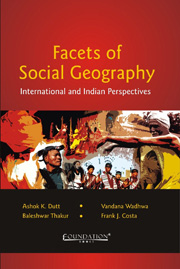Book contents
- Frontmatter
- Contents
- Foreword
- Preface
- Acknowledgements
- List of Contributors
- I Introductory Framework: Allen G. Noble's Contribution to Social Geography
- II Conceptual and Theoretical Basis of Social Geography
- III Social Geography from a Global Perspective
- 9 Regional Patterns of Spanish-Language Newspaper Publication in the United States, 1848–1992
- 10 Enterprise Zones in a Global Perspective: Socioeconomic Consequences
- 11 Multi-faceted Regional Inequality in China
- 12 Social Geography of the Minorities in Israel
- 13 Urban Sprawl and Socioeconomic Change in the Kathmandu Valley, Nepal
- 14 Ave Maria: A Planned Town in Collier County, Florida
- IV Social Geography in the Indian Context
- V Indian Social Geography: City and State Context
- Index
13 - Urban Sprawl and Socioeconomic Change in the Kathmandu Valley, Nepal
from III - Social Geography from a Global Perspective
Published online by Cambridge University Press: 05 June 2012
- Frontmatter
- Contents
- Foreword
- Preface
- Acknowledgements
- List of Contributors
- I Introductory Framework: Allen G. Noble's Contribution to Social Geography
- II Conceptual and Theoretical Basis of Social Geography
- III Social Geography from a Global Perspective
- 9 Regional Patterns of Spanish-Language Newspaper Publication in the United States, 1848–1992
- 10 Enterprise Zones in a Global Perspective: Socioeconomic Consequences
- 11 Multi-faceted Regional Inequality in China
- 12 Social Geography of the Minorities in Israel
- 13 Urban Sprawl and Socioeconomic Change in the Kathmandu Valley, Nepal
- 14 Ave Maria: A Planned Town in Collier County, Florida
- IV Social Geography in the Indian Context
- V Indian Social Geography: City and State Context
- Index
Summary
Nepal is the most densely populated country in the Himalayas, where the population has grown from 5.5 million in 1930 (Zurink and Karan 1999) to 23 million in 2001 (Central Bureau of Statistics (CBS), 2002). Kathmandu Valley is located in a tectonic depression in the central Himalayas over flat lacustrine soils deposition. Geographically situated in the central part of Nepal, Kathmandu is the capital of the country. The Valley has a centripetal flow of rivers and streams originating in the surrounding hills and flowing out to the south from a narrow gorge. Kathmandu is located within the valley of the Bagmati river system, eight tributaries of which drain the city. The river system has always been the city's main source of water for drinking and irrigation and it holds religious, cultural and social value for the Nepalese (Asian Development Bank/International Centre for Integrated Mountain Development, (ICIMOD), 2006). Three local administrative districts – Kathmandu, Lalitpur and Bhaktapur lie in the Katmandu Valley. According to the Local Self-Governance Act 1999 of the Government of Nepal, these districts are further divided into smaller local administrative and development units – one metropolitan city, one municipality and 57 Village Development Committees (VDCs) in Kathmandu district, one submetropolitan city and 41 VDCs in Lalitpur district, and, two municipalities and 16 VDCs in Bhaktapur district. The district boundary in most cases follows the water divide except for a small southern part of Lalitpur district (Fig. 13.1).
- Type
- Chapter
- Information
- Facets of Social GeographyInternational and Indian Perspectives, pp. 236 - 251Publisher: Foundation BooksPrint publication year: 2012
- 2
- Cited by



